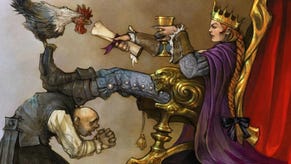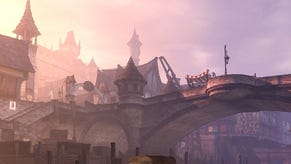Fable III
Rule of fun.
It was hardly Milo & Kate. When Peter Molyneux trotted out onto the stage at Microsoft's E3 press conference two weeks ago, it was to slap a 26th October release date on Fable III, introduce a new trailer - and then get out of the way of the bullet train of ultra-marketable Kinect software steaming onto the stage, sharpish.
Molyneux's blue-sky thinking is a great asset to Lionhead and Microsoft Game Studios, and he can still generate excitement and debate like few other game designers. But he's learned the hard way about over-promising, that sometimes it's best to shut up and let the games do the talking. So it was at E3 2010, not just at the conference, but with Fable III itself.
Lionhead felt it had something else to prove this time - that its game was real, full of the stuff that it had been talking about, and you could play it. To that end, it landed what must have been one the largest and most comprehensive playable demos of the year on the E3 show floor.
The demo comes in two parts, one doing the ramshackle rustic comedy thing with a bit of freeform questing, trading and conversation dotted around the village of Brightwall. The second showcases combat, storytelling and a more serious and epic mood in Shadelight Dungeon. I get to sit down and explore them both at relative leisure, in the company of a couple of Lionhead guides, away from the hubbub of E3 itself.
"It's all there. This is a bit of a different Lionhead, really," scripter Ted Timmins tells me. "There's no broken promises this time around... In the past it was all talk and no show. What we've come to E3 with is a message that everything we talk about, we can show you in some form on the screen."
Well, not quite everything. We still didn't get to see anything of Fable III's Big Idea, which will see your character become the ruler of Albion halfway through the game's story, and have to manage the expectations of the supporters you've gathered en route, while making decisions about the future of your kingdom even as you continue your quest.
It's a fascinating prospect, of course, but one with a huge and potentially unwieldy scope that could be hard to reconcile with the streamlined accessibility Molyneux was so keen to highlight when we saw the game earlier in the year.
To be fair, Lionhead is hardly saying more about kingship than the nothing it's showing. But Timmins - who along with senior artist Jon Eckersley is overflowing with pride and enthusiasm for the game, even after a long day of demoing it on the show floor - isn't above teasing us a bit.
"What's great about [the ruling stuff] is the game doesn't actually end when you think it should. It carries on for double the amount of time. We feel we've crafted a longer experience, almost two games in one, a game that changes so much halfway that it feels like the second half is a completely new experience," he says.
"When you're King, some of the decisions you make will change a level from what you've seen it to be to being something completely new and different."
Enticing stuff, but in the spirit of the new Lionhead, let's get down to what's in front of us. The cheerful, pastoral, sunny town of Brightwall shows no signs of the creeping onset of industrial revolution, so evident in the smoky metropolis we saw back in February. Clothing fashions have moved on, but otherwise this is the Albion you remember: equal parts Tolkien, Jane Austen, Monty Python and Disney's Camelot; saucy, scenic and stereotypically English.









